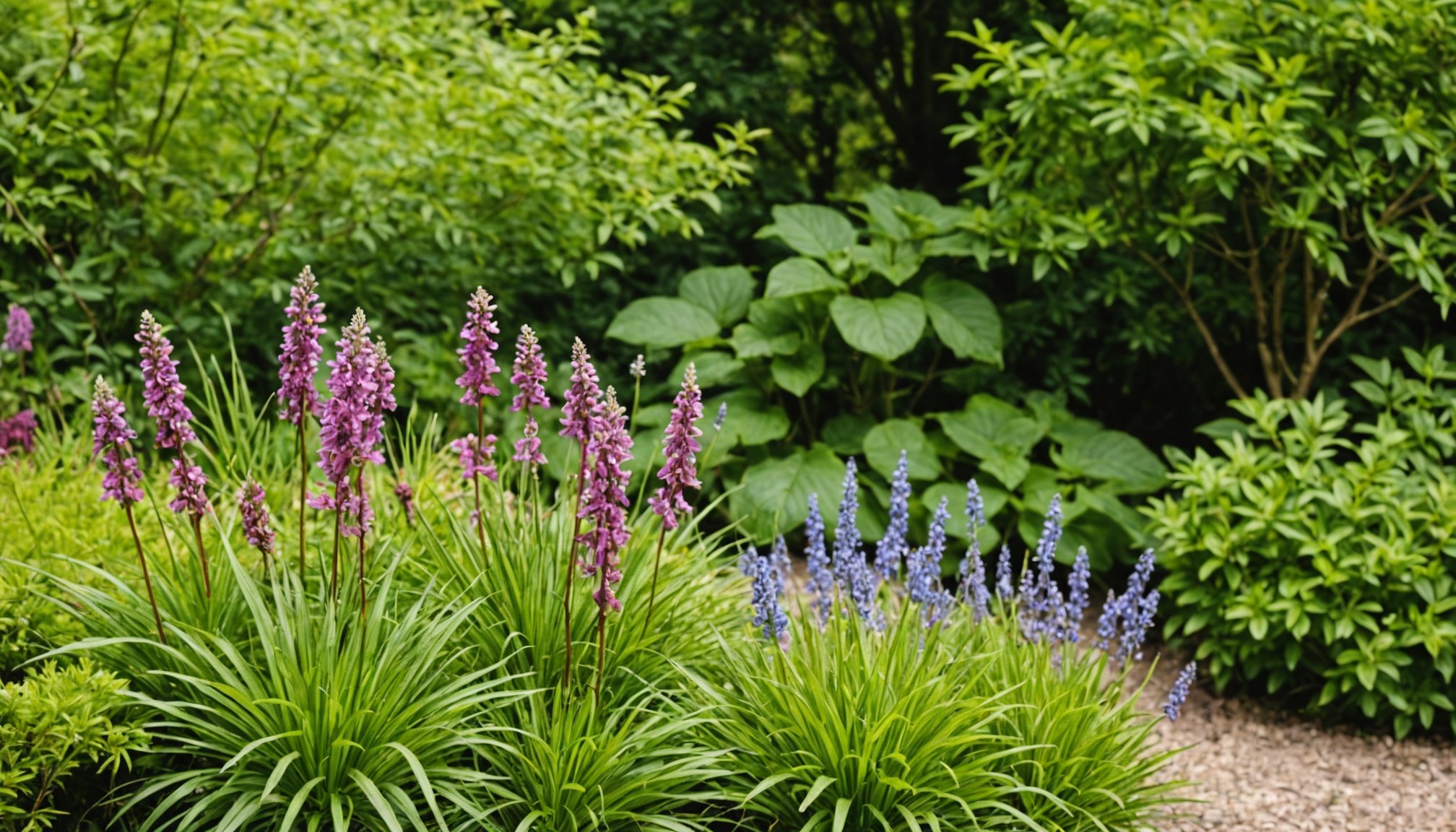Transform your garden into a low-maintenance haven with native UK plants. These resilient species not only thrive in local conditions but also support our ecosystem. Discover how to create a beautiful landscape that flourishes with minimal effort while attracting wildlife. This guide highlights top choices that combine aesthetics with simplicity, proving that gardening can be both effortless and rewarding. Embrace the natural beauty of your surroundings and cultivate a sanctuary that benefits both you and the environment.
Benefits of Using Native Plants in Gardens
Incorporating native plants into your garden offers numerous advantages. These plants are adapted to local conditions, making them an environmentally friendly choice. One of the primary environmental advantages is their ability to thrive without the need for excessive watering or chemical inputs, such as fertilisers and pesticides. This not only conserves water but also reduces pollution, contributing to a healthier ecosystem.
A voir aussi : What are the top tips for successfully incorporating a mezzanine in a UK loft conversion?
Additionally, native plants are cost-effective and require low maintenance. Once established, they need less care compared to non-native species, leading to savings in both time and resources. Their natural resilience to local pests and diseases means less money spent on treatments and upkeep.
Moreover, native plants play a crucial role in supporting local wildlife and biodiversity. They provide essential habitat and food sources for native insects, birds, and other wildlife. By planting native species, gardeners can help maintain the ecological balance and support the survival of local fauna.
En parallèle : What are the best hypoallergenic fabric choices for UK bedrooms?
In summary, choosing native plants for your garden not only benefits the environment but also your wallet and the local wildlife. Embracing these plants can transform your garden into a sustainable haven that thrives with minimal intervention.
Top Low-Maintenance Native Plants for UK Gardens
Choosing low-maintenance native plants ensures your garden remains vibrant with minimal effort. These plants are not only resilient but also well-suited to the UK's climate.
Overview of Selected Plants
Several native plants stand out for their low-maintenance nature. Lavender, for instance, is a popular choice due to its aromatic foliage and beautiful purple blooms. Foxglove captivates with its tall spikes of tubular flowers, attracting pollinators like bees. Yarrow is another excellent option, known for its feathery leaves and clusters of small flowers.
Care Requirements
These plants require little intervention once established. Lavender thrives in well-drained soil and sunny spots, needing only occasional pruning to maintain its shape. Foxglove prefers partial shade and moist soil, with self-seeding properties that make it easy to propagate. Yarrow is drought-tolerant and needs minimal watering, adapting well to various soil types.
Visual Appeal
Each plant offers unique aesthetic qualities. Lavender adds a touch of elegance with its soft hues and pleasant scent. Foxglove provides height and drama with its striking flower spikes. Yarrow brings a splash of colour with its vibrant blooms, enhancing the garden's visual diversity.
Planting and Care Tips
Planting native plants in your garden requires attention to timing and technique to ensure success. The ideal period for planting is during the autumn or early spring. This allows the plants to establish roots before the growing season or winter dormancy. When planting, ensure the hole is twice as wide as the root ball but no deeper, to encourage root spread.
Understanding soil preferences is crucial for thriving native plants. Most native species are adapted to local soil types, but some may benefit from soil amendments. For instance, sandy soils might need organic matter to improve water retention, while clay soils could require sand or grit for better drainage. Testing your soil can guide necessary modifications.
Watering and fertilisation are minimal for native plants once established. Initially, regular watering is essential until roots take hold. Thereafter, watering should be infrequent, mimicking natural rainfall patterns. Fertilisation needs are generally low; however, a light application of organic fertiliser in early spring can boost growth.
By following these guidelines, your native plants will not only survive but flourish, offering environmental benefits and aesthetic appeal with minimal ongoing effort.
Designing Your Low-Maintenance Garden
Creating a low-maintenance garden involves thoughtful planning and design. By focusing on garden design, you can achieve a beautiful and functional space that requires minimal upkeep.
Layout Ideas
Start by considering the layout of your garden. A well-organised layout maximises space and enhances accessibility. Opt for curved pathways to add visual interest and guide visitors through the garden. Group plants with similar care requirements together to streamline maintenance efforts. Raised beds can be an excellent choice for those looking to reduce physical strain and improve soil quality.
Colour Schemes
Selecting a cohesive colour scheme can transform your garden into a harmonious retreat. Consider using a monochromatic palette for a serene look or a complementary palette for vibrant contrast. Incorporate plants with different bloom times to ensure year-round colour. Foliage with varied textures and shades can add depth and interest even when flowers are not in bloom.
Incorporating Hardscaping
Hardscaping elements, such as patios, pathways, and walls, contribute to a garden's structure and functionality. Use materials like stone, gravel, or wood to complement the natural landscape. Hardscaping not only reduces the area requiring regular upkeep but also provides areas for relaxation and entertainment. Ensure that these elements blend seamlessly with the plant life for a cohesive design.
Sustainable Gardening Practices
Embracing sustainable gardening practices can significantly enhance the health of your garden while reducing environmental impact. One of the key practices is composting, which involves recycling organic waste into nutrient-rich soil. Composting reduces landfill waste and enriches the soil, promoting healthier plant growth. It can be as simple as collecting kitchen scraps and garden waste in a compost bin.
Mulching is another effective technique. Applying a layer of organic material over the soil helps retain moisture, suppresses weeds, and adds nutrients as it decomposes. It is an excellent way to conserve water, especially in dry seasons, and can be done using materials like straw, wood chips, or grass clippings.
Water conservation is crucial in sustainable gardening. Techniques such as drip irrigation or using rain barrels to collect rainwater can drastically reduce water usage. These methods ensure that water is delivered directly to the roots, minimising evaporation and runoff.
Additionally, encouraging beneficial insects like ladybirds and bees can naturally control pests and improve pollination. Planting a variety of flowers and herbs can attract these helpful insects, creating a balanced ecosystem within your garden. By implementing these practices, your garden can thrive sustainably and contribute positively to the environment.
Seasonal Care for Native Plants
Caring for native plants requires attention to seasonal changes to ensure they thrive year-round. Each season brings unique tasks and opportunities to enhance plant health and garden aesthetics.
Spring Preparation
Spring is the ideal time to prepare your garden for the growing season. Begin by pruning dead or damaged branches to encourage new growth. This is also the perfect time to apply a light layer of organic fertiliser to boost plant vigour. As temperatures rise, monitor soil moisture and adjust watering schedules to prevent stress on emerging plants.
Summer Maintenance
During summer, focus on maintaining moisture levels. Mulching is beneficial, as it helps retain soil moisture and suppresses weeds. Water early in the morning or late in the evening to minimise evaporation. Keep an eye out for pests and diseases, and address any issues promptly to protect your plants.
Fall Cleanup
Autumn is all about preparing for dormancy. Remove fallen leaves and debris to prevent disease and pests. Consider applying a fresh layer of mulch to insulate roots against winter cold. Fall is also a great time for planting new native species, as cooler temperatures and increased rainfall support robust root development.
Common Pests and Diseases
Maintaining a healthy garden involves understanding pest management and recognising common pests that may affect your plants. Identifying these pests early is crucial to prevent damage. Common culprits include aphids, which suck sap from plants, and slugs, notorious for eating leaves and stems. Caterpillars can also cause significant harm by devouring foliage.
Once identified, natural pest control methods can be employed to manage these nuisances effectively. Introducing beneficial insects like ladybirds can naturally reduce aphid populations. Handpicking slugs or setting up beer traps can help control their numbers without chemicals. For caterpillars, using organic sprays made from neem oil can be an effective deterrent.
Preventative measures are essential for maintaining plant health and reducing the likelihood of pest infestations. Regularly inspecting plants for signs of pests can catch issues early. Encouraging biodiversity by planting a variety of species can create a balanced ecosystem that naturally controls pest populations. Additionally, ensuring plants are healthy through proper watering, mulching, and soil care can make them more resilient to pests and diseases.
By integrating these strategies, gardeners can effectively manage pests and protect their plants, ensuring a thriving garden environment.
Resources for Further Learning
Expanding your knowledge of gardening can be both rewarding and practical. There are numerous resources available to help you delve deeper into the world of native plants and sustainable practices.
Books and Guides
Books and guides are excellent resources for both beginners and experienced gardeners. Look for titles that focus on native plant gardening, such as "Bringing Nature Home" by Douglas Tallamy, which offers insights into the ecological benefits of native plants. Guides like "The Wildlife Gardener" by Kate Bradbury provide practical tips for creating wildlife-friendly gardens.
Online Communities
Engaging with online communities can provide valuable advice and support. Platforms like the Royal Horticultural Society's forums or Reddit's gardening subreddit are bustling with enthusiasts eager to share their experiences and solutions. These communities are perfect for asking questions, sharing successes, and learning from others’ mistakes.
Local Gardening Clubs
Joining a local gardening club can offer hands-on experience and camaraderie. These clubs often host workshops, plant swaps, and garden tours. They are a fantastic way to connect with other gardening enthusiasts and gain practical insights specific to your region. Many clubs also provide access to exclusive resources and expert talks.
Visual Inspiration for Your Garden
Finding garden inspiration can transform your space into a stunning, low-maintenance haven. Exploring case studies of successful native plant gardens provides valuable insights and ideas. For example, a garden in Sussex utilised native wildflowers to create a vibrant meadow-like setting, attracting local pollinators and requiring minimal upkeep. Such examples highlight the potential of native plants in crafting beautiful, sustainable gardens.
Infographics and Plant Combinations
Infographics are excellent tools for visualising effective plant combinations and layouts. They can illustrate how to pair plants like Lavender and Yarrow to enhance visual appeal while maintaining low care requirements. These visual aids simplify the process of selecting and arranging plants, ensuring a cohesive design that thrives with minimal intervention.
Importance of Visual Aesthetics
The role of visual aesthetics in garden design cannot be overstated. A well-designed garden not only pleases the eye but also encourages engagement with nature. Incorporating elements like curved pathways and varied textures creates dynamic spaces that are both functional and attractive. By focusing on aesthetics, gardeners can enjoy a beautiful environment that supports local biodiversity and requires little maintenance.






